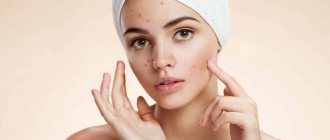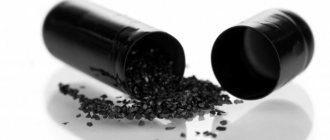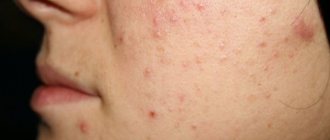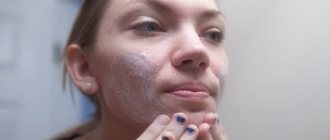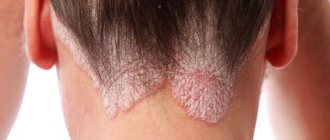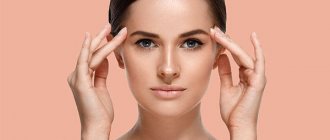Acne is a chronic inflammatory disease that affects the sebaceous glands. Improper secretion of sebum leads to its accumulation in the ducts and their clogging, and this contributes to the occurrence of inflammatory processes and their manifestation on the surface of the skin. The causes of malfunctions in the sebaceous glands are many and quite varied, but there is one that almost always affects the functioning of the body's endocrine system - changes in hormonal levels. What is it, and why does its condition have the greatest impact on our skin? Let's try to find out.
Hormones of our body
Hormones are a collection of organic substances that have biological activity. Their creation occurs in the endocrine glands. Hormones are important in human life because they regulate the most important functions in the body - growth, metabolism (metabolism), sexual development.
Hormonal activity leads to excessive oil production by the sebaceous glands, as well as changes in the quality of sebum
Hormonal levels are the proportions of certain hormones in the human body. Its change can be caused by a huge number of reasons related to internal and external factors. This may include:
- age-related changes in the body;
- the presence of various diseases;
- instability of psycho-emotional state;
- the presence of certain developmental anomalies;
- climate change.
During the cold season, certain physiological processes slow down due to changes in the proportions of hormones, and in the spring, the phenomenon of a “hormonal explosion” is observed.
Both men and women are susceptible to physiological changes in hormonal levels. The female sex suffers from this disease more often due to the characteristics of the body. In men, the most noticeable hormonal disruption occurs during puberty, in women - even during pregnancy and in connection with the menstrual cycle.
Hormones that provoke acne are: testosterone, dihydrotestosterone, dehydroepiandrosterone, and insulin-like growth factor-1
Hormones are the main regulator of the activity of the entire body; any changes in their composition and proportions affect the functioning of the entire endocrine system and the functioning of the sebaceous glands. Therefore, acne and hormones are two absolutely interrelated concepts, and if you are worried about acne, you need to take tests to determine your hormonal levels and seek help from a specialist.
Steroid hormones
Steroid hormones are based on cholesterol. These include sex hormones (androgens and estrogens) and adrenal hormones (glucocorticoids and mineralocorticoids).
Steroids play an important role in the functioning of the body, so any change in their concentration in the blood causes a number of reactions, and acne is one of them.
Women often suffer from shifts in these hormones: various gynecological diseases, menstrual irregularities, pregnancy, postmenopause and much more.
Acne examination
Agree that few people seek advice after the appearance of acne, much less go for examination. As soon as we have tried all kinds of cosmetics and traditional medicine on ourselves, without bringing results, we are often inclined to think about professional treatment. This is precisely the whole problem, since the lack of a correct diagnosis, that is, an established cause of acne, and, accordingly, the lack of correct and effective therapy can only contribute to the aggravation of this process.
If you immediately go to a specialist (in our case, visit a dermatologist), then you will be prescribed, first of all, a blood test. As a rule, a general blood test is prescribed for acne, and if the need arises, biochemical and DBS blood tests may be prescribed.
Acne and pimples very often occur due to hormonal changes during puberty, most often these problems occur in adolescents with oily skin
For a more complete picture, the doctor may also send you for other tests. In particular, to check the presence of microbial flora. If laboratory tests indicate that you have acne with altered hormonal levels, hormonal tests may be prescribed.
What to do if all tests are normal, but acne on your face does not go away?
A situation where the tests are normal, but there are still acne, may indicate that not all tests have been taken or an incomplete examination has been carried out by all specialists. If everything described above has been done and the reasons for the appearance of acne could not be found, then most likely heredity plays a major role in the occurrence of acne. It happens that all hormones are produced in sufficient quantities, but the susceptibility of sebocyte receptors to them is increased, or there is hereditary hyperplasia of the sebaceous glands, and then we see the clinical picture of the disease.
Hormonal causative agents of acne
There are many questions about what tests and what hormones need to be tested for hormonal disorders. However, it is hormone tests for acne that make it possible to determine the presence of these disorders. So, let's figure out what hormones are released during acne. Medical studies have shown that the most common causes of acne are changes in the level of:
- steroids;
- androgens, including testosterone.
Steroids, if their amount in the body increases sharply, are capable of triggering chemical processes of increased production of sebum by the sebaceous glands. If there are problems with the removal of this secretion to the surface of the skin, rashes appear.
According to statistics, girls suffer from acne more often than boys.
Androgens can provoke the appearance of a rash due to the fact that an increase in their level in the body can not only increase the volume of secretion produced by the sebaceous glands, but also change its consistency. When a secretion of increased viscosity and density is released, the ducts intended for its removal to the surface of the skin become clogged and, thus, various acne appears.
As for the level of testosterone, an increase in its level in the human body can cause certain reactions of the skin if there is a genetic predisposition to this. So, if one of the parents had acne during puberty, then with a high degree of probability we can say that a similar situation can happen to their children.
In teenagers
Previously, it was believed that the appearance of acne in teenagers was associated with hormonal surges, but now the main reason is considered to be heredity and poor nutrition.
A close relationship between hormones and skin condition can be seen in adolescents. It is the rapid hormonal surge that is the main cause of acne at this age.
In particular, increased levels of androgens lead to dermatological problems. They actively stimulate the production of sebum, which subsequently clogs the ducts of the sebaceous glands and provokes the appearance of acne. Both girls and young men experience increased levels of androgens during puberty.
In addition, the situation may be aggravated by heredity. If one or both of the parents suffered from acne at a young age, then their child is likely to develop the disease as well. Therefore, during the period of puberty of a son or daughter, parents should be very careful about this.
Determination of hormone levels
If you have a rash on your skin and you suspect that it is acne due to a hormonal imbalance, you should not immediately rush to the laboratories and ask the question: “What hormones should I test for acne?” It is worth knowing that some experts generally do not recommend hormonal tests for acne, explaining that the level of each of them is quite variable, and therefore the analysis will show it only at a specific point in time.
Acne due to hormonal disorders can be diagnosed by doctors without the help of special laboratory tests - based on the results of general and biochemical blood tests, as well as cultures of microbial flora. But in some cases, doctors may prescribe additional examinations, usually to determine the level of free testosterone - to find the cause of acne in particularly complex cases.
Most often, such studies are prescribed to women. So, in women, in connection with the menstrual cycle, there may be constant rashes that progress during the days of hormonal release, and therefore, when observing these symptoms, it is often enough to donate only blood to establish testosterone levels in order to understand whether acne is caused by hormones or whether you need to look for another reason for the appearance eels.
Thus, the main thing is not to decide on your own which tests to take and how to interpret their results. In any case, examinations should be prescribed by a doctor depending on the need for them.
Our skin is a mirror of the whole organism; pathologies occurring inside a person are almost immediately reflected on the skin. The skin suffers especially severely due to hormonal imbalance; at the slightest deviation from the norm, acne appears on the skin. Most often, skin rashes are observed in adolescence, when the body undergoes active hormonal changes. Acne and hormones in women are often associated with menstruation, but usually the rash appears and goes away within 3-4 days after the end of the menstrual cycle. Some female representatives suffer from acne on their faces until old age; of course, hormonal imbalance is also to blame for this. Let's consider what tests need to be taken to determine whether hormones are normal? But first, let’s find out what hormonal acne is, and why do they often bother women?
Hormonal acne
Dermatologists distinguish several classifications of acne, depending on various parameters. So, regarding the reason that prompted the development of acne, acne is divided into hormonal and non-hormonal. In most cases, patients experience acne of a hormonal nature. And there is a simple explanation for this.
The fact is that skin glands and hair follicles are hormonally dependent. Therefore, any changes and deviations in the functioning of the endocrine system are immediately reflected in their work. This also explains the fact that not only teenagers are susceptible to acne.
Doctors note in which cases hormonal acne can occur, quickly turning into a severe form, and what hormones contribute to this:
- In teenagers. In adolescence, both girls and young men experience hormonal changes and surges, as well as increased levels of androgens (steroids).
- In pregnant women. In women during pregnancy, progesterone levels are increased. The same picture is observed in those who have recently given birth.
- In women in the second phase of the cycle. Before menstruation, girls also have increased progesterone levels, which is why they so often complain of rashes a few days before their period.
- For gynecological diseases. Any problems in the field of women's health can lead to serious problems with the skin of the face.
- When treated with anabolic steroids, progesterone, and steroids, the development of acne is quite possible.
- The influence of psycho-emotional state. Depression, stress, and nervous breakdowns contribute to an increase in the level of male sex hormones. Therefore, in girls and adult women, this can cause severe acne.
If the disease has taken a serious turn, and no cosmetologist’s procedures help, it is better not to waste time and consult a dermatologist. He, in turn, will refer the patient to an endocrinologist, and the girl will definitely refer her to a gynecologist. Also, the doctor will certainly order a blood test: you will need to take hormone tests.
What are hormonal breakouts?
Of course, there are many reasons why acne appears on the face, but today we will look at hormonal imbalances. If basic medications and other methods do not help get rid of skin rashes, then the doctor prescribes hormone tests. Many patients ask the same questions: is it necessary to do this research, to find out how hormonal imbalance affects the manifestations of acne? And how to recognize hormonal acne?
Let us recall that if the functioning of at least one internal organ in the body is disrupted, then a change in hormonal levels immediately occurs, which usually leads to increased secretion of the sebaceous glands.
The secretion becomes very viscous and thick, as a result of which pores become clogged, sebum accumulates in the ducts and causes inflammation.
Most often, pathologies of the following organs cause fluctuations in hormonal levels in the body:
- brain;
- ovaries;
- adrenal glands;
- endocrine glands;
- hypothalamus.
It is malfunctions in the functioning of these organs that affect the appearance of skin rashes. All inflammations are divided into several types:
- blackheads or comedones, which are a closed-type sebaceous plug with a black head, mostly appear on the nasolabial triangle;
- sebaceous-horn plugs, inside of which there is pus, appear as a result of infection on the dermis, the immune system begins to resist bacteria, as a result of which purulent contents accumulate, it is usually covered by the skin (subcutaneous pimples) or it has an outlet in the form of a so-called crater;
- inflammation in the pustules, which can either intensify or fade, also has purulent contents. In the acute period, there is redness of the skin around, thickening at the site of inflammation; such rashes take a long time to heal and are difficult to treat.
The most unpleasant situation caused by hormonal imbalance is a combination of pustules and papules, which can form extensive lesions of the skin, often leaving scars and scars after such inflammation.
Diagnosis of allergic rashes
The allergy skin test method is a fairly simple but effective procedure for identifying allergens.
The examination process consists of several stages:
- Synthetic analogues of allergens are applied to an area of the patient's skin, from the hand to the shoulder.
- Shallow incisions are made in places of contact with the skin.
- Over the next few minutes, an allergic reaction should appear on the skin, which will indicate a specific pathogen.
Skin diseases can have serious consequences. Therefore, even if it is not possible to visit the clinic on your own, you should call a dermatologist at home, where the skin will be examined with a number of necessary manipulations to identify the cause of the skin rash.
Methods for diagnosing skin diseases:
- Diagnosis of skin diseases
- Diagnosis of skin diseases at home
- Diagnosis of allergic skin diseases
- Diagnosis of bacterial skin diseases
- Diagnosis of viral skin diseases
- Diagnosis of hair diseases
- Diagnosis of nail diseases
- Diagnosis of skin tumors
- Skin scraping
- Blisters on the skin
- Dermatoscopy
- Demodex tests
- Diagnosis of sexually transmitted infections
- Mushroom tests
- Skin scraping
Skin is the mirror of the body
Based on the location of skin rashes on the face, it is possible to determine which organ pathologies caused hormonal imbalance. Acne and hormones are interconnected in all women, but such an organ that is suffering is easy to recognize just by looking at the face:
- forehead - gastrointestinal tract or bladder, between the eyebrows - liver suffers;
- temples, ears, near the ears - kidneys;
- cheeks - respiratory organs;
- chin - hormonal surge (especially on women's days);
- area around the mouth - diseases of the oral cavity.
Now let's consider which series of hormone tests for acne should be taken first?
Basic tests
So, what hormones should be tested if the skin rashes are not treatable? It is worth noting that it is not enough to just go and donate blood for hormones, you need a full examination, and you will need to consult several specialists: an endocrinologist, a gynecologist, a dermatologist. Doctors will prescribe which tests to take after a more detailed examination of the patient.
The goal of the entire comprehensive examination is to determine which hormones affect acne in a particular case. The cause of skin rashes may be different for all women.
Hormones that provoke inflammation
To identify the cause of the rash, you need to determine the hormones and get tested for them. Let's get acquainted with two types of hormones that affect skin rashes, changes in the level of production of which provoke acne:
- Androgens are a type of steroid hormone. Their level especially increases in adolescence. These are male hormones, but they are also produced in small quantities by the female body. During puberty, secretory cells begin to actively work, which triggers the production of sebum with a thick consistency. The skin ducts become clogged, microcomedones appear, which over time begin to become inflamed and in their place closed (subcutaneous) comedones appear or with an exit in the form of a crater. Such plugs simply do not allow sebum to come out.
- The male hormone testosterone is also produced in the female body. Often, increased secretion of testosterone in women has a genetic cause. The higher the level of testosterone in the body, the worse acne appears in women.
What hormones trigger acne?
There are 2 hormones, the increase in levels of which most often leads to the development of acne.
Steroid hormones
In particular, we are talking about androgens. The most common cause of acne in teenagers is an increase in androgens. These are male hormones that are also present in women. In adolescents, their level sharply increases, which is a trigger for starting chemical reactions, as a result of which sebocytes, that is, secretory cells of the sebaceous glands, are intensively produced.
This, in turn, increases the amount of sebum secreted, which has a very thick consistency. Sebum clogs the ducts, which causes acne. First, microcomedones appear, which over time transform into open or closed comedones. These plugs do not allow subcutaneous fat to come out freely. Therefore, it remains in the ducts in which propionic bacteria begin to multiply.
In fact, they are always present in the sebaceous glands, but do not manifest themselves. If they begin to multiply vigorously, they provoke the development of acne and other inflammatory elements. For example, ulcers are also their consequence. The hair follicle expands under the influence of bacteria and can rupture, resulting in an abscess.
Testosterone
It is a male sex hormone that is produced in both men and women. In this case, the influence of genetics is great, since the hormonal background and skin characteristics of the parent (or parents) are copied. Thus, the type of skin and its reactions is inherited by a person.
The higher the testosterone level, the higher the risk of skin problems such as acne, etc.
In tests for sex hormones, which are prescribed by a dermatologist, endocrinologist or gynecologist, the most informative in determining the causes of acne are indicators of steroid hormones and testosterone.
Steroid
Steroid hormones, in particular androgens, have a great influence on the functioning of the sebaceous glands.
These are male sex hormones that are produced in the body regardless of gender.
Sebum becomes quite thick in order to freely exit through the sebaceous ducts.
- They become blocked and microcomedones appear on the skin, which over time turn into closed or open comedones.
- Sebum remains in the ducts and pimples appear on the skin.
A study of their contents showed that propionic bacteria actively multiply there, which are normally always found in the sebaceous glands, but when they function normally and sebum is released, they do not cause harm.
Basic indicators
So, what tests are taken if acne bothers you: mainly a blood test for hormones. In this study, experts take into account the following indicators:
- luteinizing hormone, which is responsible for the normal functioning of the entire reproductive system;
- follicle-stimulating hormone, which affects the maturation of follicles in females;
- Estradiol is a hormone in women that is produced by the ovarian follicles or adrenal glands.
It is changes in the production of these hormones that will affect the development of acne. Now let’s find out how to prepare for a hormone test for acne?
Blood test for acne
An important indicator of health in acne is a biochemical blood test. It takes into account the following indicators: bilirubin, glucose, ALT, cholesterol, creatinine, triglycerides, urea, alkaline phosphatase. This blood test can detect a wide range of problems associated with acne, including chronic inflammation, problems with the intestines or liver, and other diseases of the internal organs.
Thus, careful diagnosis and testing for pimples and acne are the key to successful treatment of acne.
Preparing for the study
What hormones are released is now known. But to make the result more reliable, you need to follow a few simple rules before taking a blood test:
- Blood is drawn on an empty stomach and in the morning;
- It is not recommended to engage in heavy physical work or experience psycho-emotional stress during the day;
- women should undergo testing on the 5th or 7th day from the start of the menstrual cycle.
And most importantly: no sweets. It is worth noting that the cause of local skin rashes can be increased insulin. And its increase is associated with a large amount of glucose in the body, because it is produced specifically to remove sugars. And eating sweet foods in unlimited quantities leads to increased production of insulin, which converts glucose into glycogen. And excess glycogen is converted into fatty acids called triglycerides. It is triglycerides that trigger the production of sebaceous glands, which leads to the formation of acne on the skin.
Let us remind you that treatment for acne should only be prescribed by a doctor after studying blood test results for hormones. Now there are a huge number of drugs that can save a woman from this unpleasant problem, for example, Acnecutane. But only after a comprehensive examination are medications prescribed.
5 minutes to read.
Tests for acne are necessary for the treatment of chronic skin pathologies. Open or closed comedones appear on the face in the form of nodes and papules.
How hormones affect the development of acne
Acne on the face occurs in adolescents under 18 years of age, but sometimes remains with a person until old age.
Dihydrotestosterone (DHT) promotes the formation of facial acne. The tendency to acne is regulated by α-melanocyte stimulating hormone, insulin, and corticotropin.
The pathogenesis of acne is associated with androgens, estrogens, progesterone, adrenocorticotropic factor (ACGG), glucocorticoids, and growth hormone.
Hormone tests for acne should be taken in patients suffering from short exacerbations and in people who tolerate standard therapy well. It is recommended to take a hormone test in case of late onset of acne (after 30 years).
How often do you get your blood tested?
Poll Options are limited because JavaScript is disabled in your browser.
- Only by prescription of the attending physician 30%, 1213 votes
Once a year and I think that’s enough 17%, 684 votes
At least twice a year 15%, 604 votes
More than twice a year but less than six times 11%, 443 votes
I take care of my health and vote once a month 6%, 250 votes
I'm afraid of this procedure and try not to give up 4%, 169 votes
21.10.2019
An increased amount of androgens (hyperandrogenism) in women leads to acne. Hormones need to be checked regularly, because comedones in the form of nodules and cystic formations indicate a large amount of androgens in the body.
Preparation for analysis
Depending on the patient’s symptoms, the doctor prescribes tests:
- for the presence of thyroid-stimulating and adrenocorticotropic hormones;
- thyroxine;
- cortisol;
- total testosterone;
- oxyprogesterone;
- estradiol
To treat acne, a pituitary prolactin test is performed. The patient is tested for follicle-stimulating and luteinizing hormones.
Tests must be taken after special preparation.
The initial data is influenced by factors such as:
- emotional overstrain.
To keep your face clean and free of acne, you need to limit your medications.
Tests are taken following the following rules:
- They arrive at the laboratory before 8 am.
- Before the procedure, you should not drink alcohol, you should eat moderately, avoid physical activity, do not visit the sauna, solarium, avoid stressful situations, the person should rest for 10-15 minutes.
- During the week before the procedure, you must stop taking medications and hormones.
- You should stop smoking 3 hours before the test.
What tests to take for hormones for acne
Depending on the symptoms, a dermatologist or gynecologist (andrologist) may prescribe an individual set of hormonal tests. Most often, at the first stage, the doctor prescribes standard hormones.
- pituitary thyrotropin and thyroxine - reflect the work of the pituitary gland and thyroid gland;
- cortisol and adrenocorticotropin - show the level of functional activity of the adrenal glands;
- free, total testosterone, dehydroepiandrosterone, sex steroid binding protein - are necessary to assess the functioning of the gonads; in women, oxyprogesterone, anti-Mullerian and estradiol are additionally examined;
- pituitary prolactin – the formation of sex hormones depends on its concentration;
- follicle-stimulating and luteinizing - stimulate the maturation of the follicle, the synthesis of progesterone, testosterone.
Watch the video about tests for acne:
What tests to take for acne
Many patients are interested in what tests to take for acne on the face.
For acne in women, hormone tests are prescribed. Androgens during sexual activity lead to acne. The analysis in many cases confirms hormonal changes in the body.
Acne is a skin disease associated with blockage and inflammation of the sebaceous glands and hair follicles.
Acne usually appears on the face, neck, chest, back and shoulders and may not go away for a long time. Most often, teenagers suffer from acne. It can be expressed to varying degrees, in some cases scars form after the disease.
At the moment, there are a large number of different effective ways to treat acne.
Synonyms Russian
Acne, pimples, acne, blackheads.
English synonyms
Acne, Acne vulgaris.
Symptoms
Acne typically appears on the face, neck, chest, back and shoulders—the areas with the most sebaceous glands. They are divided into the following types.
Closed ones are small whitish soft formations with a diameter of 1-3 mm. When squeezed, their contents are released with great difficulty.
Open comedones appear as a result of blockage of the sebaceous glands, like a plug, by horny masses. Outwardly, they are similar to closed ones, but have a black center. When squeezed, the contents are easily released from them. They can also be located on the nose and appear as “blackheads”. Such comedones rarely cause inflammation.
- Papules are “raised” solid red inflammatory elements with a diameter of up to 5 mm.
- Pustules are raised structures containing pus. They are red inflammatory elements with white pus at the top.
- Nodules are hard, painful inflammatory formations more than 5 mm in diameter, located under the surface of the skin and slightly elevated above it. They are formed as a result of the accumulation of skin secretions deep inside the hair follicles.
- Cysts are painful, pus-filled, inflammatory growths under the surface of the skin. After the cyst disappears, a scar may appear.
General information about the disease
Acne is the formation of comedones, pustules, nodules and cysts as a result of blockage and inflammation of the sebaceous glands of the hair follicles.
The sebaceous glands secrete sebum, which has bactericidal properties and prevents the proliferation of microorganisms; serves as a fatty lubricant for hair and the outer layer of skin; softens the skin and gives it elasticity.
The sebaceous glands have the shape of a bubble and are located in the human skin. They are almost always associated with hair follicles (a kind of sacs in which the hair root is located), into the upper part of which the ducts of the sebaceous glands open. Released from the sebaceous gland through the ducts through the mouth of the hair follicle and pores, sebum reaches the surface of the skin. The upper part and mouth of the hair follicle are lined with skin cells; during its constant renewal, dead cells along with sebum come to the surface of the skin through the pores.
Sebaceous glands are located throughout the human body, most of them on the face, neck, back, shoulders, and chest. The largest sebaceous glands are located in these areas.
Acne occurs when dead skin and sebum clog the hair follicle. This environment is favorable for the growth of bacteria, whose activity often causes subsequent inflammation of the follicle.
As a rule, acne is inherited. If both parents had acne, three out of four of their children will also have it. If only one parent had acne, one in four children will have acne.
The appearance of acne is promoted by:
- Hyperkeratosis of the hair follicle is an excessive formation of skin cells at the mouth of the hair follicle and an associated violation of the removal of dead cells. Hyperkeratosis can occur as a result of constant irritation of the hair follicle or poor nutrition of the skin.
- Excessive sebum production.
- The presence of Propionibacterium acne is a bacteria for which the environment of a clogged hair follicle is ideal for existence and reproduction. Propionibacterium acne promotes inflammation in the clogged hair follicle.
As a rule, acne appears in adolescence, more often in boys. Almost 90% of teenagers have acne.
It is during puberty that the level of the androgen hormone increases in both boys and girls, causing increased functioning of the sebaceous glands.
Similar hormonal changes in the body may be associated with pregnancy, with the use of certain oral contraceptives and hormone-containing drugs. The subsequent increase in sebum production can also lead to acne. In some cases, acne can also occur in adulthood, more often in women.
There are three degrees of acne severity:
- Mild degree (less than 20 comedones, less than 15 inflamed elements or the total number of rashes less than 30).
- Average degree (20-100 comedones, 15-20 inflamed elements or the total number of rashes 30-125).
- Severe acne (more than 5 cysts, more than 100 comedones, more than 50 inflammatory elements or a total number of rashes more than 125).
With acne of any degree, weakening or complete disappearance of the disease usually occurs after 20 years, but in some women the rash can persist up to 40 years.
There are misconceptions related to this disease, some of them:
- Fatty foods and chocolate cause or worsen acne. In reality, the use of these products has virtually no effect on the appearance and progression of acne.
- Skin impurities cause acne. Impurities on the skin do not cause acne. On the contrary, too frequent cleansing of the skin with soap and other cosmetics can irritate the skin and worsen acne.
- Exposure to sunlight improves acne. This is not true - rather, tanning makes acne less noticeable, but the condition of the skin usually does not improve.
- Stress causes acne. Stress cannot cause acne, but it can worsen the course of an existing disease.
Who is at risk?
People at risk for developing acne include the following:
- Persons with a hereditary predisposition to the development of acne.
- People aged 12 to 25 years.
- Women, girls 2-7 days before the onset of menstruation.
- Pregnant women.
- People taking hormonal medications containing corticosteroids and androgens.
Diagnostics
The diagnosis of acne is usually made based on examination of the patient.
Laboratory research
In women with menstrual irregularities or signs of other hormonal abnormalities, an assessment of hormonal status is necessary:
- seeding of discharge from skin elements - placing the discharge in a nutrient medium, where intensive proliferation of microbes is accessible to visual assessment; allows you to exclude other inflammatory skin diseases.
Other studies
- Ultrasound of the pelvic organs if polycystic ovary syndrome is suspected as a possible cause of acne.
Treatment
Treatment of acne is aimed at reducing sebum production, reducing inflammation and the number of acne elements.
For mild acne, the mainstay of treatment is the use of retinoids. These drugs speed up the process of cell renewal, while preventing follicle clogging. Retinoids are usually used in the form of ointments. Lotions with sulfur and salicylic acid can be used as an aid to help exfoliate the skin.
In severe cases, long-term use of antibiotics (for several weeks) in the form of capsules or tablets is necessary. If antibiotics are ineffective and inflammation is very severe, isotretinion is prescribed, a retinoid that suppresses the activity of the sebaceous glands.
Hormonal medications may also be used.
In combination with antibiotics that destroy bacteria and relieve inflammation, retinoids, as a rule, have an excellent effect - acne disappears within 3-20 weeks, including severe acne. However, retinoids should not be taken during pregnancy or breastfeeding.
To get rid of large scars left after acne, chemical peeling and laser resurfacing can be used.
Prevention
After getting rid of acne, to prevent recurrence of the disease, you must follow the following rules.
- Wash your face twice a day using mild cosmetics. This will remove excess oil and dead skin cells without causing irritation.
- Use products that reduce sebum production, such as lotions with salicylic acid or zinc.
- Avoid frequent use of foundation, concealers, and greasy creams.
- Always remove makeup before going to bed.
Acne on various parts of the body usually occurs after the age of 20. They are mainly the result of disorders within the body and the progression of pathologies. Many try to solve this problem with cosmetics, masks, creams and other procedures. But the results from them are short-lived, since in order to get rid of the symptoms, it is necessary to undergo tests, clarify the specific cause and eliminate its consequences.
Rashes are a signal of serious problems. Their appearance on the body can be caused by:
- hormonal and endocrine disorders;
- diseases of the digestive system, liver, gall bladder;
- pathogenic microflora;
- impaired lipid metabolism;
- demodicosis
Also, with acne, you should pay attention to the state of the digestive or endocrine system. Hormonal imbalance occurs during adolescence and due to a malfunction of the genital organs and systems. Between the ages of 15 and 21, both sexes experience a hormonal surge. Androgen levels suddenly rise and negatively affect the skin.
In addition, heredity plays an important role. If parents had skin problems during puberty, acne, pimples, then there is a high probability that the picture will repeat in the child.
Also, in women during the menstrual cycle, the level of steroid hormones fluctuates, to which the body can respond with a reaction - a rash. If during this period it goes away on its own, then no intervention is required.
Attention! The onset of pimples due to the menstrual cycle should go away by age 28.
Often, due to a hereditary predisposition, acne spreads to a large part of the face. In this situation, tests and consultation with a dermatologist are required. If a woman (over 30 years of age) continues to be bothered by rashes, this may be a sign of inflammatory processes or polycystic ovary syndrome. The temporary cause is pregnancy or abortion. They are also a consequence of changes in the hormonal background of a woman’s body.
What other indicators are important?
During laboratory research, several more indicators are taken into account:
- Luteinizing hormone, or LH. This is a peptide hormone that is necessary for the functioning of the reproductive system. It is responsible for the secretion of estrogen in women and testosterone in men.
- Follicle stimulating hormone. It is responsible for the maturation of the follicle in women and sperm in men.
- Estradiol. It is a female sex hormone that is produced by the ovarian follicles in women, the testes in men, and the adrenal glands in both sexes.
We suggest that you familiarize yourself with Pathology of the cervix. Common types, diagnosis and treatment
It is very important to fulfill a number of conditions when taking the analysis:
- take a blood test in the morning, on an empty stomach;
- the day before, do not do physical work, do not play sports, etc.;
- women should take the test on the 5th – 7th day from the start of menstruation.
Typically, laboratory testing is carried out during the day.
It is worth noting that some doctors do not consider it advisable to send a patient for a blood test. They explain this by the fact that hormonal levels change every minute, so the result obtained during the study is nothing more than an objective assessment of what was happening in the body at the time of blood donation.
However, for patients with severe acne, laboratory testing is often the last option to get rid of acne. After such an analysis, the doctor selects adequate treatment, which consists of prescribing hormonal drugs.
Acne on various parts of the body usually occurs after the age of 20. They are mainly the result of disorders within the body and the progression of pathologies. Many try to solve this problem with cosmetics, masks, creams and other procedures. But the results from them are short-lived, since in order to get rid of the symptoms, it is necessary to undergo tests, clarify the specific cause and eliminate its consequences.
If the tests are normal, dermatologists begin to determine other causes of acne.
The following points can be highlighted here:
- disturbances in the functioning of the digestive tract - diseases of the mucous membrane of organs interfere with the proper absorption of vitamins and beneficial microelements;
- poor diet – often reducing fatty and fried foods reduces the appearance of acne;
- detection of staphylococcus - provokes the development of boils and other purulent inflammations inside human organs, this leads to intoxication and the appearance of acne;
- improper hygiene – often the lack of regular hygiene causes the formation of comedones and other types of acne.
To determine the cause, you should be open and honest with your dermatologist.
The connection between certain hormones and acne
Hormonal imbalance is reflected in the skin. Androgens, which are steroid hormones, affect the functioning of the sebaceous glands. This male hormone is present in any body, regardless of gender. An increase in its concentration in the body leads to the appearance of abundant secretions from the sebaceous glands. As a result of the changes, sebum becomes much thicker and more difficult to come out. The process leads to clogged pores and the formation of subcutaneous comedones, which eventually turn into pimples.
Another provoking hormone for acne is testosterone (a male sex hormone that is also present in the female body in small quantities). As it increases, the likelihood of rashes also increases. Also, during a certain period of life, there is a natural increase in testosterone in the blood.
But to determine all these changes in a woman’s body, a thorough diagnosis is required. During testing, the amount of the following hormones is determined:
- follicle-stimulating;
- luteinizing;
- estradiol.
All these components are found in representatives of both sexes. When diagnosing health conditions, endocrinologists pay attention to the percentage of prolactin, cortisol, and dihydrotestosterone.
Important! Hormonal imbalance can be the result of serious medical conditions. An increased content of androgenic hormones occurs with hyperplasia of the adrenal cortex and tumor formations of the ovaries.
The thyroid gland, which produces thyroxine, triiodothyronine and thyroid-stimulating hormone, is also examined. Disturbances in its functioning also cause the appearance of acne. Only by checking the concentration of these substances can it be determined that everything is normal in the body.
The effect of hormones on the skin
Tests will help not only identify the nature of acne, but also determine which hormones are responsible for the development of the disease. There may be several options. The first of these is androgens.
An imbalance of these steroid hormones is the most common and usually occurs during adolescence. These male sex hormones are also produced in girls. If androgen levels are elevated, a woman may experience acne. Why is this happening? With a sharp increase in the level of steroid hormones, sebocytes begin to be overproduced. And these cells, in turn, produce excessive amounts of subcutaneous fat, which leads to inflammation.
The situation is aggravated by the fact that androgens contribute not only to the secretion of sebum, but also to a change in its texture and consistency. It becomes more viscous, thick, dense. Because of this, it cannot pass freely through the sebaceous ducts. As a result, the last and hair follicles become blocked. All this is the cause of the development of acne.
What hormones contribute to the development of acne?
Another common cause of acne is high testosterone levels.
It is worth noting that this reason is due to heredity. Moreover, if both parents of a patient with acne had such a diagnosis, then the predisposition increases significantly. This picture is especially typical for teenagers. If a child's parents did not suffer from acne at a young age, then the likelihood of skin problems is sharply reduced, and vice versa.
Against the background of all the processes described above, uncontrolled reproduction of propionic bacteria also occurs. The latter are found in hair follicles and sebaceous ducts. If the skin is healthy, they do not make themselves felt. But clogged passages provide an excellent breeding ground for bacteria, as a result of which they begin to actively multiply, provoking the appearance of new acne.
Which doctor should I contact?
If a rash appears periodically, a woman should first undergo a visual examination by a dermatologist. Then he may refer the patient to other specialists, which include:
- Gynecologist. For most women, serious disorders are directly related to diseases of the genital organs.
- Gastroenterologist. Less common, but skin problems that arise due to disorders of the digestive system. This diagnosis is confirmed or refuted by a gastroenterologist.
Important! In some cases, acne occurs due to an allergic reaction of the body to different types of medications.
What tests need to be taken
For acne on the face and body, the following tests are performed:
- blood – tested for CSR, for biochemical and general diagnosis;
- skin scraping - shows the presence or absence of pathogenic microflora on the surface of the skin;
- thyroid hormones;
- smear.
Preparation
Tests may show incorrect results if certain rules of preparation for taking them are neglected. Regardless of the type, the following instructions must be followed:
- Take tests early in the morning on an empty stomach;
- Sex hormones are taken from women on the fifth, sixth, seventh day after the menstrual cycle.
- The day before your planned visit to the doctor, avoid sexual intercourse, sports, and physical activity.
When is it necessary to get tested immediately?
If the treatment prescribed by a dermatologist does not produce an effective result within two to three weeks, the doctor may refer the woman for testing. If you have acne, it is advisable to get tested as early as possible.
What tests can tell you
Test results may show that the cause of the rash is:
- Diseases of the liver, gall bladder.
- Endocrine disorders.
- Disorders of the thyroid gland.
- Increased hormone levels.
There are also reverse diagnoses, when the patient expects a worse verdict, but it turns out that acne arose due to improper care of problem skin. Any of the results are not terrible, since early detection of the problem will help you get rid of it faster.
Why are tests for facial acne necessary?
There are not many reasons for the appearance of acne on the face; they can act both separately and in combination. These include the following:
- excess secretion production by the sebaceous glands,
- hyperkeratosis – excessively thick top layer of skin,
- imbalance of hormones in the blood,
- presence of pathogenic microorganisms.
Despite the small number of causes, diagnosing acne is extremely important, since it helps to identify the leading etiological factor and its features, in particular, how exactly the hormonal balance in the body is disturbed, what pathogens aggravate the course of acne.
If acne appears on the skin, you should consult a specialist: a dermatologist can help determine an effective solution to the problem. In a number of situations, consultations with a gynecologist, endocrinologist, and andrologist may be required.
At your first appointment, your dermatologist may examine the skin scraping using microscopy. This helps to identify a rather rare cause of acne - subcutaneous demodex mites. In this case, the specialist will immediately prescribe suitable corrective measures to combat the tick and strengthen the immune system.
Hormonal, biochemical and other studies are especially necessary in the following situations:
- acne manifestations are observed after 20 years,
- the number of rashes on the face and body exceeds 40 active lesions (this indicates a late stage of acne),
- women exhibit symptoms of hyperandrogenism,
- instability of the menstrual cycle in women,
- the patient's body mass index exceeds normal values.
All of the above should be a reason to immediately consult a doctor and carry out all the necessary diagnostic procedures.
